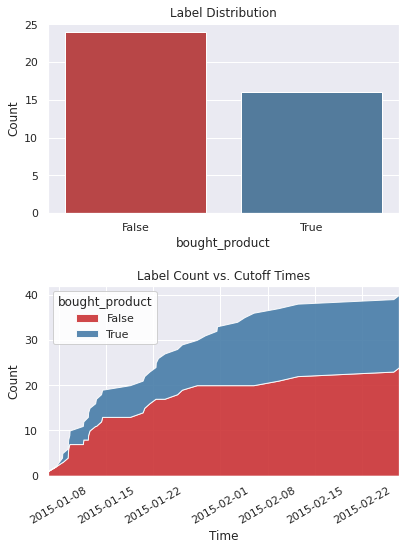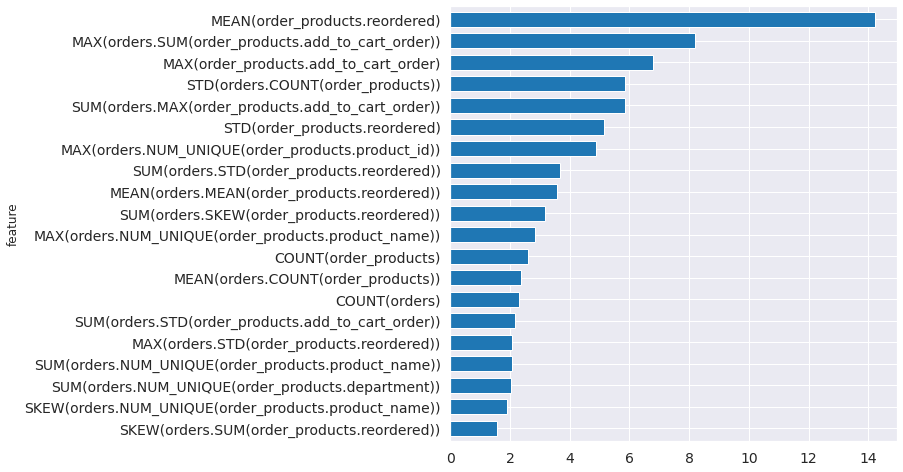Predict Next Purchase¶
In this example, we build a machine learning application to predict whether customers will purchase a product within the next shopping period. This application is structured into three important steps:
Prediction Engineering
Feature Engineering
Machine Learning
In the first step, we generate new labels from the data by using Compose. In the second step, we generate features for the labels by using Featuretools. In the third step, we search for the best machine learning pipeline by using EvalML. After working through these steps, you will learn how to build machine learning applications for real-world problems like predicting consumer spending. Let’s get started.
[1]:
from demo.next_purchase import load_sample
from matplotlib.pyplot import subplots
import composeml as cp
import featuretools as ft
import evalml
We will use this historical data of online grocery orders provided by Instacart.
[2]:
df = load_sample()
df.head()
[2]:
| order_id | product_id | add_to_cart_order | reordered | product_name | aisle_id | department_id | department | user_id | order_time | |
|---|---|---|---|---|---|---|---|---|---|---|
| id | ||||||||||
| 0 | 120 | 33120 | 13 | 0 | Organic Egg Whites | 86 | 16 | dairy eggs | 23750 | 2015-01-11 08:00:00 |
| 1 | 120 | 31323 | 7 | 0 | Light Wisconsin String Cheese | 21 | 16 | dairy eggs | 23750 | 2015-01-11 08:00:00 |
| 2 | 120 | 1503 | 8 | 0 | Low Fat Cottage Cheese | 108 | 16 | dairy eggs | 23750 | 2015-01-11 08:00:00 |
| 3 | 120 | 28156 | 11 | 0 | Total 0% Nonfat Plain Greek Yogurt | 120 | 16 | dairy eggs | 23750 | 2015-01-11 08:00:00 |
| 4 | 120 | 41273 | 4 | 0 | Broccoli Florets | 123 | 4 | produce | 23750 | 2015-01-11 08:00:00 |
Prediction Engineering¶
Will customers purchase a product within the next shopping period?
In this prediction problem, we have two parameters:
The product that a customer can purchase.
The length of the shopping period.
We can change these parameters to create different prediction problems. For example, will a customer purchase a banana within the next 5 days or an avocado within the next three weeks? These variations can be done by simply tweaking the parameters. This helps us explore different scenarios which is crucial for making better decisions.
Defining the Labeling Process¶
Let’s start by defining a labeling function that checks if a customer bought a given product. We will make the product a parameter of the function.
[3]:
def bought_product(ds, product_name):
return ds.product_name.str.contains(product_name).any()
Representing the Prediction Problem¶
Then, let’s represent the prediction problem by creating a label maker with the following parameters:
target_entityas the columns for the customer ID, since we want to process orders for each customer.labeling_functionas the function we defined previously.time_indexas the column for the order time. The shoppings periods are based on this time index.window_sizeas the length of a shopping period. We can easily change this parameter to create variations of the prediction problem.
[4]:
lm = cp.LabelMaker(
target_entity='user_id',
time_index='order_time',
labeling_function=bought_product,
window_size='3d',
)
Finding the Training Examples¶
Now, let’s run a search to get the training examples by using the following parameters:
The grocery orders sorted by the order time.
num_examples_per_instanceto find the number of training examples per customer. In this case, the search will return all existing examples.product_nameas the product to check for purchases. This parameter gets passed directly to the our labeling function.minimum_dataas the amount of data that will be used to make features for the first training example.
[5]:
lt = lm.search(
df.sort_values('order_time'),
num_examples_per_instance=-1,
product_name='Banana',
minimum_data='3d',
verbose=False,
)
lt.head()
[5]:
| user_id | time | bought_product | |
|---|---|---|---|
| 0 | 2555 | 2015-01-22 09:00:00 | False |
| 1 | 3283 | 2015-01-08 13:00:00 | True |
| 2 | 5360 | 2015-01-21 11:00:00 | False |
| 3 | 5669 | 2015-01-09 08:00:00 | False |
| 4 | 5669 | 2015-01-12 08:00:00 | True |
The output from the search is a label times table with three columns:
The customer ID associated to the orders.
The start time of the shopping period. This is also the cutoff time for building features. Only data that existed beforehand is valid to use for predictions.
Whether or not the product was purchased. This is calculated by our labeling function.
As a helpul reference, we can print out the search settings that were used to generate these labels. The description also shows us the label distribution which we can check for imbalanced labels.
[6]:
lt.describe()
Label Distribution
------------------
False 24
True 16
Total: 40
Settings
--------
gap None
minimum_data 3d
num_examples_per_instance -1
target_column bought_product
target_entity user_id
target_type discrete
window_size 3d
Transforms
----------
No transforms applied
We can also get a better look at the labels by plotting the distribution and cumulative count across time.
[7]:
%matplotlib inline
fig, ax = subplots(nrows=2, ncols=1, figsize=(6, 8))
lt.plot.distribution(ax=ax[0])
lt.plot.count_by_time(ax=ax[1])
fig.tight_layout(pad=2)

Feature Engineering¶
In the previous step, we generated the labels. The next step is to generate the features.
Representing the Data¶
We will represent the online grocery orders using an entity set. This way, we can generate features based on the relational structure of the dataset. We currently have a single table of orders where one customer can many orders. This one-to-many relationship can be represented by normalizing an entity for customers. The same can be done for departments, aisles, and products. Let’s structure the entity set.
[8]:
es = ft.EntitySet('instacart')
es.entity_from_dataframe(
dataframe=df.reset_index(),
entity_id='order_products',
time_index='order_time',
index='id',
)
es.normalize_entity(
base_entity_id='order_products',
new_entity_id='orders',
index='order_id',
additional_variables=['user_id'],
make_time_index=False,
)
es.normalize_entity(
base_entity_id='orders',
new_entity_id='customers',
index='user_id',
make_time_index=False,
)
es.normalize_entity(
base_entity_id='order_products',
new_entity_id='products',
index='product_id',
additional_variables=['aisle_id', 'department_id'],
make_time_index=False,
)
es.normalize_entity(
base_entity_id='products',
new_entity_id='aisles',
index='aisle_id',
additional_variables=['department_id'],
make_time_index=False,
)
es.normalize_entity(
base_entity_id='aisles',
new_entity_id='departments',
index='department_id',
make_time_index=False,
)
es["order_products"]["department"].interesting_values = ['produce']
es["order_products"]["product_name"].interesting_values = ['Banana']
es.plot()
[8]:
Calculating the Features¶
Now, we can generate features by using a method called Deep Feature Synthesis (DFS). This will automatically build features by stacking and applying mathematical operations called primitives across relationships in an entity set. The more structured an entity set is, the better DFS can leverage the relationships to generate better features. Let’s run DFS using the following parameters:
entity_setas the entity set we structured previously.target_entityas the customers, since we want to generate features for each customer.cutoff_timeas the label times that we generated previously.
[9]:
fm, fd = ft.dfs(
entityset=es,
target_entity='customers',
cutoff_time=lt,
cutoff_time_in_index=True,
include_cutoff_time=False,
verbose=False,
)
fm.head()
[9]:
| COUNT(orders) | SUM(order_products.add_to_cart_order) | SUM(order_products.reordered) | STD(order_products.add_to_cart_order) | STD(order_products.reordered) | MAX(order_products.add_to_cart_order) | MAX(order_products.reordered) | SKEW(order_products.add_to_cart_order) | SKEW(order_products.reordered) | MIN(order_products.add_to_cart_order) | ... | NUM_UNIQUE(orders.MODE(order_products.product_id)) | NUM_UNIQUE(orders.MODE(order_products.product_name)) | MODE(orders.MODE(order_products.department)) | MODE(orders.MODE(order_products.product_id)) | MODE(orders.MODE(order_products.product_name)) | COUNT(order_products WHERE department = produce) | COUNT(order_products WHERE product_name = Banana) | NUM_UNIQUE(order_products.orders.user_id) | MODE(order_products.orders.user_id) | bought_product | ||
|---|---|---|---|---|---|---|---|---|---|---|---|---|---|---|---|---|---|---|---|---|---|---|
| user_id | time | |||||||||||||||||||||
| 2555 | 2015-01-22 09:00:00 | 2 | 3 | 2 | 0.707107 | 0.000000 | 2 | 1 | NaN | NaN | 1 | ... | 1.0 | 1 | dairy eggs | 27086.0 | Half & Half | 0.0 | 0.0 | 1 | 2555 | False |
| 3283 | 2015-01-08 13:00:00 | 2 | 28 | 6 | 2.160247 | 0.377964 | 7 | 1 | 0.000000 | -2.645751 | 1 | ... | 1.0 | 1 | produce | 13176.0 | Bag of Organic Bananas | 2.0 | 0.0 | 1 | 3283 | True |
| 5360 | 2015-01-21 11:00:00 | 2 | 903 | 37 | 12.267844 | 0.327770 | 42 | 1 | 0.000000 | -2.440735 | 1 | ... | 1.0 | 1 | snacks | 4142.0 | 6 OZ LA PANZANELLA CROSTINI ORIGINAL CRACKERS | 2.0 | 0.0 | 1 | 5360 | False |
| 5669 | 2015-01-09 08:00:00 | 3 | 66 | 9 | 3.316625 | 0.404520 | 11 | 1 | 0.000000 | -1.922718 | 1 | ... | 1.0 | 1 | produce | 4097.0 | Almonds & Sea Salt in Dark Chocolate | 4.0 | 1.0 | 1 | 5669 | False |
| 2015-01-12 08:00:00 | 3 | 157 | 22 | 3.599265 | 0.282330 | 13 | 1 | 0.072227 | -3.219960 | 1 | ... | 2.0 | 1 | dairy eggs | 4097.0 | Almonds & Sea Salt in Dark Chocolate | 7.0 | 1.0 | 1 | 5669 | True |
5 rows × 116 columns
There are two outputs from DFS: a feature matrix and feature definitions. The feature matrix is a table that contains the feature values based on the cutoff times from our labels. Feature definitions are features in a list that can be stored and reused later to calculate the same set of features on future data.
Machine Learning¶
In the previous steps, we generated the labels and features. The final step is to build the machine learning pipeline.
Splitting the Data¶
We will start by extracting the labels from the feature matrix and splitting the data into a training set and holdout set.
[10]:
y = fm.pop('bought_product')
splits = evalml.preprocessing.split_data(
X=fm,
y=y,
test_size=0.2,
random_state=0,
)
X_train, X_holdout, y_train, y_holdout = splits
Finding the Best Model¶
Then, we run a search on the training set for the best machine learning model.
[11]:
automl = evalml.AutoMLSearch(
problem_type='binary',
objective='f1',
random_state=0,
)
automl.search(
X=X_train,
y=y_train,
data_checks='disabled',
show_iteration_plot=False,
)
Using default limit of max_pipelines=5.
Generating pipelines to search over...
*****************************
* Beginning pipeline search *
*****************************
Optimizing for F1.
Greater score is better.
Searching up to 5 pipelines.
Allowed model families: xgboost, catboost, random_forest, linear_model, extra_trees
(1/5) Mode Baseline Binary Classification P... Elapsed:00:00
Starting cross validation
Finished cross validation - mean F1: 0.000
(2/5) Extra Trees Classifier w/ Imputer + O... Elapsed:00:00
Starting cross validation
Finished cross validation - mean F1: 0.391
(3/5) Elastic Net Classifier w/ Imputer + O... Elapsed:00:02
Starting cross validation
Finished cross validation - mean F1: 0.000
(4/5) CatBoost Classifier w/ Imputer Elapsed:00:04
Starting cross validation
Finished cross validation - mean F1: 0.422
(5/5) XGBoost Classifier w/ Imputer + One H... Elapsed:00:04
Starting cross validation
Finished cross validation - mean F1: 0.290
Search finished after 00:06
Best pipeline: CatBoost Classifier w/ Imputer
Best pipeline F1: 0.421958
Once the search is complete, we can print out information about the best pipeline found, such as the parameters in each component.
[12]:
automl.best_pipeline.describe()
automl.best_pipeline.graph()
**********************************
* CatBoost Classifier w/ Imputer *
**********************************
Problem Type: Binary Classification
Model Family: CatBoost
Pipeline Steps
==============
1. Imputer
* categorical_impute_strategy : most_frequent
* numeric_impute_strategy : mean
* categorical_fill_value : None
* numeric_fill_value : None
2. CatBoost Classifier
* n_estimators : 10
* eta : 0.03
* max_depth : 6
* bootstrap_type : None
[12]:
Now, let’s score the model performance by evaluating predictions on the holdout set.
[13]:
best_pipeline = automl.best_pipeline.fit(X_train, y_train)
score = best_pipeline.score(
X=X_holdout,
y=y_holdout,
objectives=['f1'],
)
dict(score)
[13]:
{'F1': 0.8}
From the pipeline, we can see which features are most important for predictions.
[14]:
feature_importance = best_pipeline.feature_importance
feature_importance = feature_importance.set_index('feature')['importance']
top_k = feature_importance.abs().sort_values().tail(20).index
feature_importance[top_k].plot.barh(figsize=(8, 8), fontsize=14, width=.7);

Next Steps¶
At this point, we have completed the machine learning application. We can revisit each step to explore and fine-tune with different parameters until the model is ready for deployment. For more information on how to work with the features produced by Featuretools, take a look at the Featuretools documentation. For more information on how to work with the models produced by EvalML, take a look at the EvalML documentation.